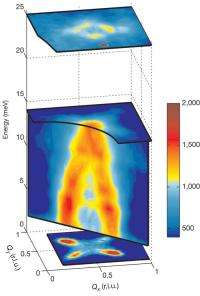Stripes 'play key role' in superconductivity

(PhysOrg.com) -- Fluctuating magnetic stripes could be the cause of the mysterious hourglass-shaped magnetic spectrum found in high temperature superconductors, according to new research.
Scientists at Oxford University and the Institut Laue-Langevin have used neutrons to probe the magnetic ‘glue’ thought to produce high temperature superconductivity and have identified stripes of magnetic moments and charge as the cause of a strange hourglass-shaped magnetic spectrum. Their findings, reported in Nature, are a step forward in the search for a model of high temperature superconductivity.
Current research into the origins of high temperature superconductivity found in a large class of copper oxide compounds centres on the motion of atomic magnetic moments. Fluctuations of these moments are believed to create an attractive force (a sort of magnetic ‘glue’) which binds electrons in pairs and allows them to move around unimpeded giving rise to superconductivity.
Recent debate has focused on the cause of an unusual hourglass shape found in the spectrum of these magnetic fluctuations. The origin of this pattern, which is found in many if not all high temperature superconductors, is thought to relate to an alternating pattern of spin and charge stripes found within the atomic layers but so far it has been hard to prove a link between the two phenomena.
The researchers instead turned their attention to an insulating cobalt oxide with a similar magnetic stripe pattern. Using neutron scattering at the ILL the scientists measured the atomic-scale fluctuations in its magnetism and uncovered the same hourglass pattern in the data. Their results provide strong evidence that magnetic stripes are the cause of the hourglass spectrum and play an important role in high temperature superconductivity.
‘Our cobalt oxide compound is a magnetic look-alike for the high temperature superconductors,’ said Professor Andrew Boothroyd of Oxford University’s Department of Physics, who led the work at Oxford. ‘Its lack of mobile electrons prevents it from becoming superconductive, allowing us to use neutron scattering to look in detail at nano-scale fluctuations in the magnetic motion without the complicating effects of superconductivity. The experiment allows us to isolate the source of the much-debated hour-glass spectrum.’
A report of the research, ‘An hour-glass magnetic spectrum in an insulating, hole-doped antiferromagnet’, is published in this week’s Nature.
More information: Nature, Volume 471, Pages: 341–344, 17 March 2011. www.nature.com/nature/journal/ … ull/nature09902.html
Provided by Oxford University


















